A Quick Tour of the North Island
I’ve been pretty quiet since my last post in May, but a lot has been going on. For one thing, in June in an act of coordination and grace worthy of Baryshnikov, I had a fall at the farm and broke my leg. It sounds worse than it was and in retrospect was kind of a nice break. No pun intended. On second thought, yes, it was intended.
However there was hell to pay when I started walking again in October and had to catch up on all the things that had to be done on the farm. After a few hectic weeks and lots of willing volunteers, we got the place looking pretty good and even got some good publicity. If you want to see my rather inauspicious television debut you can have a look here.
We’d planned an overseas trip for August but because I couldn’t travel we didn’t do it. So we had a mini-vacation this past week with a trip down to Wellington to visit some friends. We decided to mix work with pleasure and stopped at a series of ecological restoration projects along the way to find out what other people are doing.
This was our route:
There are a lot of ecological restoration projects underway around New Zealand. The objective is to restore native forests and to create habitat for threatened NZ flora and fauna, especially birds.
Before humans came, there were no mammals except for a small bat. As a result, birds didn’t have to worry about predators and over time they lost the ability to fly. Many NZ native birds are flightless and even if they can fly, they often spend a lot of their time on the ground and some even build their nests on the ground.
When humans arrived with rats, cats, dogs, weasels and stoats, a lot of native birds’ days were numbered and today many of them are either extinct or seriously endangered. In addition to predators, other introduced pests such as rabbits and possums destroy the habitat of many birds by eating vegetation.
The local communities, with assistance from the local councils and the Department of Conservation have established several bird sanctuaries on offshore islands where it is reasonably practical to control predators, however over the past decade thanks to the initiative of several community groups around the country, a few mainland sanctuaries have been established too.
Several of the mainland sanctuaries are enclosed by predator proof fences. The fences are expensive to build and to maintain but they do a good job of protecting both native plants and animals. There are also open sanctuaries with no fences, like ours. We rely on predator control through trapping and poisoning but without a predator proof fence it is a challenge for a sanctuary to release some of the most endangered birds and animals. We visited three fenced sanctuaries and three open reserves.
The first place we visited was Rotokare Reserve near Eltham, Taranaki.
We arrived on Sunday afternoon and virtually had the place to ourselves. The entry is kind of scary because you have to go through two gates in the big fence. The 8.2 km long and 2 m high fence is even topped with an electric wire—very welcoming!
You press a button and drive through the first gate which then closes behind you. Only then can you press the button to open the second gate.
This reserve has a large lake in the middle which is open to the public for water sports. This has posed interesting challenges because the needs and expectations of the recreational water sporting enthusiasts and the environmentalists are not always consistent. But over time people have learnt to comprise and they are co-existing well.
We walked the 4 km track along the lake and saw some amazing mature native trees.
Bushy Park, which is near Whanganui on the way to Wellington, also has the same sort of double gate system.
But it is unusual in that the stately home of the person who gifted the land to the trust is inside the sanctuary.
We saw the biggest and oldest known rata tree in NZ – estimated to be about 800 hundred years old with a height of 42 metres (142 ft) and a girth of 11.9 metres. A Rata starts life by germinating in the branches of a host tree. It then grows downwards and eventually completely surrounds and kills the host. As a result, rata trees are almost always hollow.
The walk was very peaceful and we saw many threatened native birds like saddlebacks and stitch birds that have been released in the sanctuary. Plus a friendly New Zealand robin followed us around for a while.
The last fenced sanctuary we visited is Maungatautari near Cambridge. It is the largest fenced sanctuary in NZ encompassing 3400 hectares (8400 acres).
This sanctuary is another good example of how communities with competing interests can come together for the common good. Several neighbouring farmers and local Maori have generously given their land for the creation of this sanctuary.
It is on the top of an extinct volcano and surrounded by a 47 km (28 mile) fence.
We spent a few nice hours walking around the various tracks within the sanctuary and encountered lots of birds. This is a kaka, one of NZ’s native parrots who can be friendly to the point of appearing aggressive.
In addition to the fenced sanctuaries, we also visited three open nature reserves, Nga Manu in Waikanae, Paengaroa near Whanganui and Otari Wilton in Wellington. Nature reserves without fences have a completely different feel.
The only warning was to watch out for pukeko, a very interesting bird.
These are pukekos:
Actually there was another warning sign– that this bridge in Paengaroa could only take one person at a time. It actually felt like one was too many!
Although we spent a lot of time in the reserves, most of our time was spent enjoying the sights and people we encountered along the way. Rotokare is in Taranaki and the region gets its name from Mount Taranaki, a volcano. You may have noticed that I didn’t say “extinct volcano.” It is referred to as “active but quiescent” and the fact that they think it will wake up some time in the next 50 years doesn’t make me very quiescent.
The mountain is 2,500 metres (8,300 feet) high and dominates the landscape of Taranaki.
We spent the night in Hawerea and this was the view from our room.
A bit of trivia. Hawera means “burnt place” in Maori because during a tribal battle a village was burned down. Coincidentally, over the years, the town of Hawera has had three huge fires and as a result a big (and fancy) water tower was built to ensure that there would be enough water to fight any future fires.
And this is the local library.
On the drive we saw a lot of interesting sights. Like this patriotic barn.
This is hay-making season and a lot of farmers have hay in plastic covered bales waiting to be sold or stored.
But in some areas they had pink plastic for breast cancer awareness—a new program started in the past couple of months to raise health awareness in rural areas.
Most of the towns in Taranaki are booming because of the dairy industry but this one seemed a bit too quiet on a Monday morning!
We continued on our way to Wellington.
We encountered a lot of entertaining road signs along the way. Here is the sign announcing that you’ve arrived in Bulls, a prosperous farming town of 1,700.
We spent a few relaxing days in Wellington with our friends Pauline and Steve. On the way back we drove for a while along the Kapiti Coast which is the southwestern coast of the North Island. It is lined with small communities and black sandy beaches and we braved the crowds at Pekapeka Beach.
Behind me in the photo above is Kapiti Island which is an island eco-sanctuary.
We were heading north towards Lake Taupo, which is a big lake virtually in the centre of the North Island. On the way we passed some picturesque old settlements.
This interesting horse caught our eye.
But then we saw the sign.
We passed through Taihape (pronounced Tie happy), population 2,000, which calls itself the Gumboot Capital of the World and welcomes you with a giant gumboot statue.
And here is the Taihape town hall.
I was curious about the town name and found that it was originally Otaihape and that in Maori it means “home of Tai the hunchback.”
Lake Taupo is located on a high plateau and as we approached, the landscape changed from farms and forests to tussock.
This part of the North Island is very geologically active and we passed Tongariro National Park which is home to three active volcanos—Ruapehu, Tongariro and Ngaruhoe. This is Ruapehu which last erupted in 2007, badly injuring a climber.
Lake Taupo is actually the caldera crater of a monstrous volcano that erupted about 27,000 years ago. It was supposedly the largest volcanic eruption in history and it has affected the geology of the entire country, covering the soil with several feet of volcanic ash and changing the course of rivers. The lake is 616 square kilometres (238 square miles) and is the size that Singapore was before they started making Singapore bigger by reclaiming land.
Today Lake Taupo is one of NZ’s most popular recreation areas with skiing in the mountains and fishing in the lake. You can tell by the little towns along the way that you are getting close to the lake and a recreation area.
The lake is clean and beautiful and peaceful.
But it’s a little disconcerting because as you walk along the edge you will see little bare areas with steam escaping as the lake is fed by underground hot water springs. It’s hard to see the steam in the picture but I stuck my hand in the water and believe me, you don’t want to keep it there long, and you can see the mineral deposits that have formed as well. The water gets colder further away from the lake edges and in the centre the lake is 186 metres (600 feet) deep.
The lake is ringed with both vacation and permanent homes, from the very basic:
To the more opulent:
We had a nice walk around the lake and met some interesting natives and visitors. We came across a guy hitting golf balls into the lake and stopped to find out what he was up to.
He was running the Lake Taupo Hole in One project. On the platform in the lake are three holes with the smallest being a regulation sized golf hole. If you get a hole in one you win $10,000 and there are lesser prizes for getting the ball in the larger holes or even for getting the ball on the platform. Divers go out to retrieve the balls. And the occasional club.
They charge $1 for one ball and you can also buy buckets of 18 or more balls. I figured I’d give it a try for a buck. The guy took one look at me at me and very kindly handed me two balls in exchange for my dollar.
How did I do? Suffice it to say that this picture doesn’t include the landing zones of my two efforts. However, the guy did tell us that over the last 7 years 19 people have won the $10,000 prize!
We spent the night at Lake Taupo and then headed north towards our last stop before Auckland.
A must see attraction just on the outskirts of Lake Taupo is Huka Falls. It is a gorge where the Waikato River, New Zealand’s longest river leaves the lake and starts its flow. Because a huge amount of water is trying to get through a small area there is a lot of activity and a beautiful waterfall.
Because of all the volcanic activity in the area there are a number of geothermal attractions. Our next stop was a place called Craters of the Moon. It is a big area with several vents leaking steam. There is a sulphur smell in the air and the chemicals coming up with the fumes have stained the surrounding soil and prevent anything but scrub vegetation from growing.
It’s real steam coming out of the ground and the holes are very deep so they don’t fool around:
We then headed to Orakei Korako. In Maori, Orakei Korako means “adorned place” and the name refers to the colourful mineral deposits that have come out of the hot springs and geysers. According to the literature, 20 million litres (about 5 million gallons) of water flows up out of the springs every day and into Lake Ohakuri which was formed when a hydroelectric dam was built on the Waikato River. You take a boat ride across the lake and explore the pools and streams.
It’s hard to tell from this picture, but that pool is boiling and bubbling away.
And this is a bubbling mud pool.
We headed back to Auckland after stopping at Maungatautari. I realised that I hadn’t been stuck in traffic or had to stop at a red light since we’d left!
We returned home rejuvenated with lots of good ideas and energized by the positive community networking we had a chance to experience. It’s great to see that even communities with different interests can live and work together for the common good.
Happy holidays and all the best in 2015!











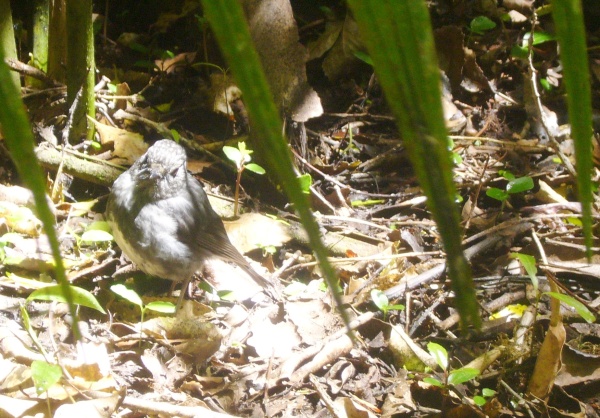













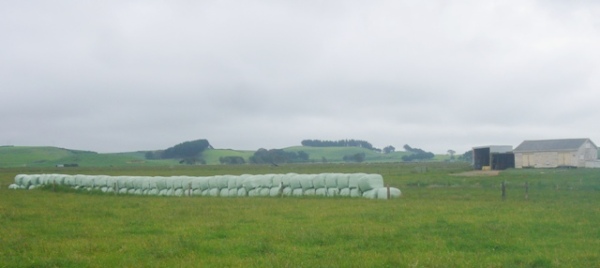
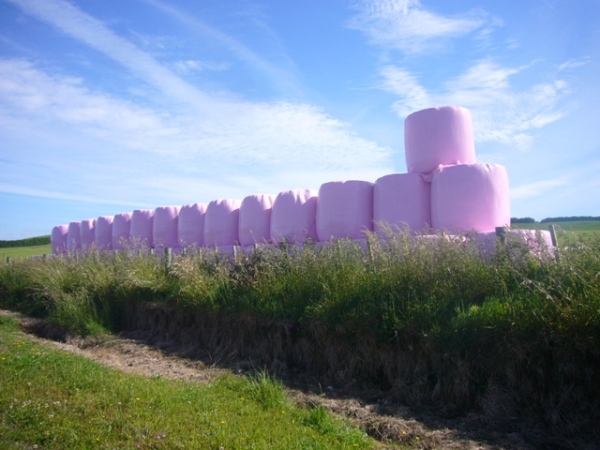


















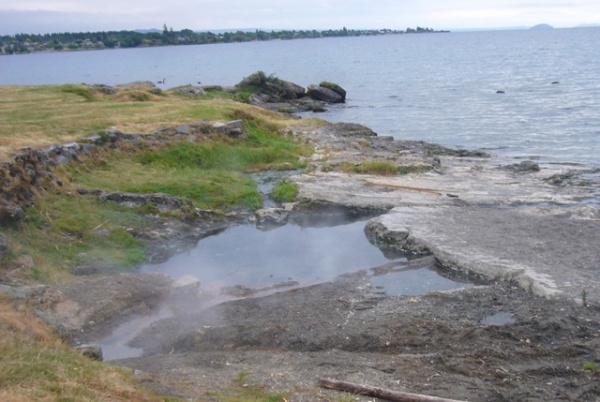







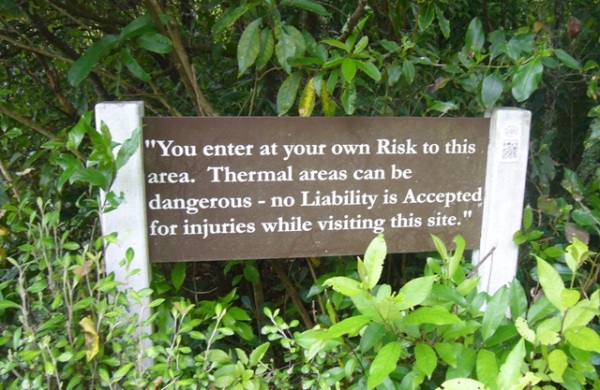
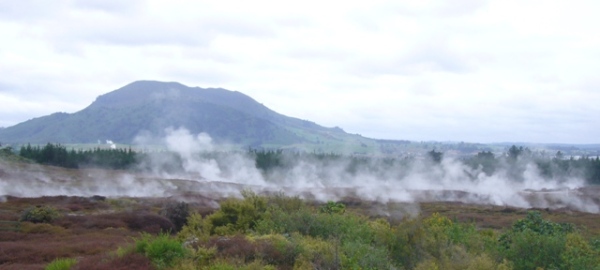



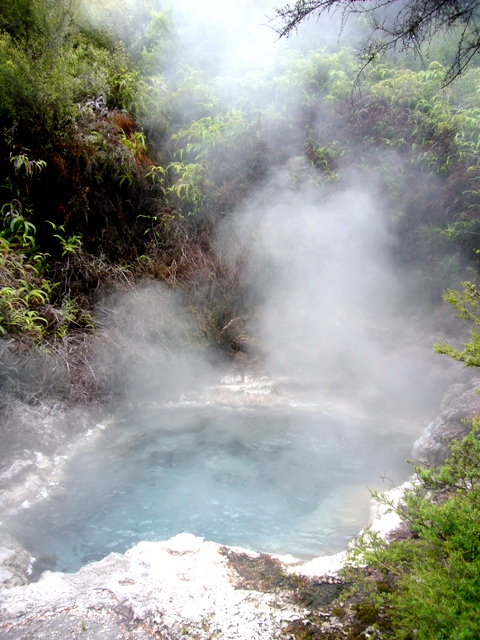




Hi Tom,
Wonderful to see your photos and know that you have been restored to health again. I also appreciated the natural history. Happy Holidays to you and your family from Ron and me…here on the TK Rancho.
Thanks Cheri! Hope you have a great holiday season with your family and friends.
I’m not a doctor, but a broken hand would seem more consistent with taking a break from blogging than a broken leg.
In order to combat the plague of mammals that endanger the flightless birds, wouldn’t it be time to introduce snakes to New Zealand? The snakes, of course, would have to be trained to go after the stoats and weasels and leave the birds alone, but there are snake whisperers for that.
So where are you planning to go once the conservation project that “we won’t be taking with us when we’re gone” has been completed and gifted to the community? Back to Cleveland?
Very true, doctor, but I was busy working on a new novel and that diverted my attention from blogging.
As far as where I’m planning to go after the conservation project, that is a cosmological question because “gone” in “won’t be taking it with us when we’re gone” means really gone.
I see. Surely best to gift it then, for to have land or real estate shipped to heaven or hell tends to drive final expenses over the cliff.
No question about it. Plus if I end up in hell with it, I might be forced to do weeding and maintenance and chase cows for eternity!
Thanks for the tour, Tom. I enjoyed it, esp the funny signs and the divers retrieving the odd club. Fascinating to see the hot pools and steam. Such a unique environment. Happy Christmas to you and your wife and all the people of Cue Haven. xx
Thank you! And I hope you have a great holiday season and much happiness in 2015.
Tom, great to see you back in print. You mention new novel – any clues??
Again a wonderful blog full of interesting photos, brought back many happy memories. Hope 2015 is great to both you and Mahrukh, Gail & Alex.